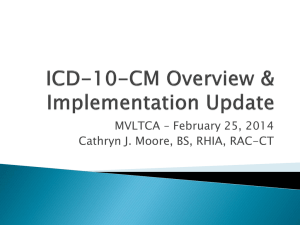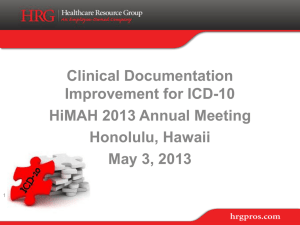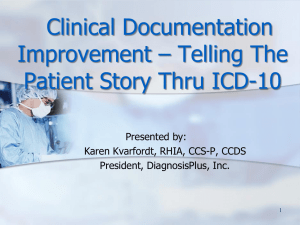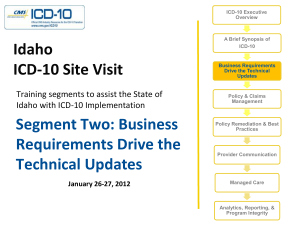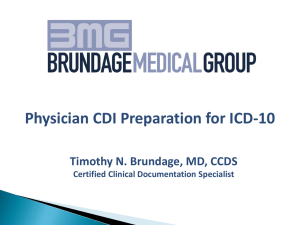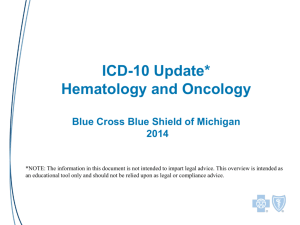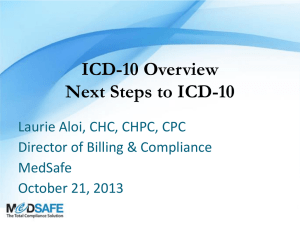ICD-10-CM – Everything You Need to Know … For Now
advertisement
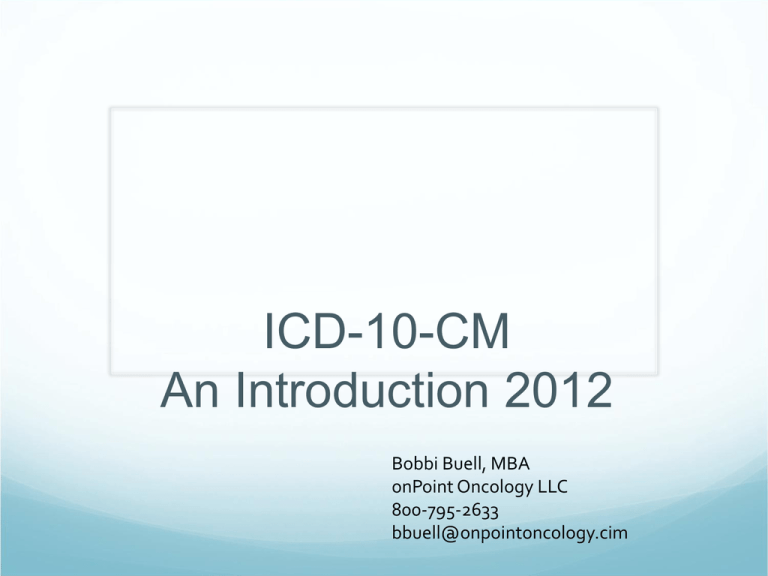
ICD-10-CM An Introduction 2012 Bobbi Buell, MBA onPoint Oncology LLC 800-795-2633 bbuell@onpointoncology.cim Create an awareness of ICD-10-CM. Start to consider the impact the conversion to ICD-10 will have on your operations. Start to understand what it means and does not mean in Oncology. Latest Update The AMA asked HHS to postpone or cancel ICD-10. CMS intimated that the deadline would be postponed. HHS is in the process of making a rule as to how the postponement will work. ICD-9-CM vs. ICD-10-CM 1) ICD-9-CM is out of date and running out of space for new codes. • • Lacks specificity and detail No longer reflects current medical practice 2) ICD-10 is the international standard to report and monitor diseases and mortality, making it important for the U.S. to adopt ICD-10 based classifications for reporting and surveillance. 3) ICD codes are the core elements of HIT systems, conversion to ICD-10 is necessary to fully realize benefits of HIT adoption. ICD-10-CM code book retains the same traditional format Index Tabular Process of coding is similar Look up a condition in the Index Confirm the code in the Tabular ICD – 9-CM ICD – 10-CM 13,600 codes 69,000 codes Code book contains 17 chapters Code book contains 21 chapters Consists of 3 to 5 characters Consists of 3 to 7 characters 1st character is alpha or numeric 1st character is alpha Only utilizes letters E and V Utilizes all letters (except U) Second, third, fourth, and fifth characters are always numeric Second character is always numeric Third, fourth, fifth, sixth, and seventh characters can be alpha or numeric Shorter code descriptions because of lack of specificity and abbreviated code titles Longer code descriptions because of greater clinical detail and specificity and full code titles ICD-9-CM CODE ICD-10-CM CODE A - Category of code A - Category of code B - Etiology, B - Etiology, anatomical site, and manifestation anatomical site, and/or severity C - Extension 7th character for obstetrics, injuries, and external causes of injury A B A B C ICD-9-CM Structure – Format Numeric or Alpha (E or V) V X E 5 4 Numeric X 1 X 4 Category . X 0 X 0 Etiology, Anatomic Site, Manifestation 3 – 5 Characters ICD-10-CM Structure – Format Alpha (Except U) M X A S X 3 X 2 Category 2 - 7 Numeric or Alpha . Additional Characters X 0 X 1 X 0 A X Etiology, Anatomic Site, Severity Added code extensions (7th character) for obstetrics, injuries, and external causes of injury 3 – 7 Characters ICD-9-CM Codes ICD-10-CM Codes Pressure ulcer codes 9 codes 707.00 – 707.09 Pressure ulcer codes 125 codes L89.0-L89.94 Codes: 707.0 Pressure ulcer 707.00 - unspecified site 707.01 - elbow 707.02 - upper back 707.03 - lower back 707.04 - hip 707.05 - buttock 707.06 - ankle 707.07 - heel 707.09 - other site Code Examples: L89.131 – Pressure ulcer of right lower back, stage I L89.132 – Pressure ulcer of right lower back, stage II L89.133 – Pressure ulcer of right lower back, stage III L89.134 – Pressure ulcer of right lower back, stage IV L89.139 – Pressure ulcer of right lower back, unspecified stage L89.141 – Pressure ulcer of left lower back, stage I L89.142 – Pressure ulcer of left lower back, stage II L89.143 – Pressure ulcer of left lower back, stage III L89.144 – Pressure ulcer of left lower back, stage IV L89.149 – Pressure ulcer of left lower back, unspecified stage L89.151 – Pressure ulcer of sacral region, stage I L89.152 – Pressure ulcer of sacral region, stage II … L89.90 – Pressure ulcer of unspecified site, unspecified stage Combination codes for conditions and common symptoms or manifestations Combination codes for poisonings and external causes Added laterality Expanded codes: injury, diabetes, alcohol/substance abuse, postoperative complications Added extensions for episode of care Inclusion of trimester in obstetrics codes and elimination of fifth digits for episode of care Expanded detail relevant to ambulatory and managed care encounters Inclusion of clinical concepts that do not exist in ICD-9-CM Changes in timeframes specified in certain codes Useful in Cancer?? Laterality – Left Versus Right C50.1 Malignant neoplasm, of central portion of breast C50.111 Malignant neoplasm of central portion of right female breast C50.112 Malignant neoplasm of central portion of left female breast Useful In Cancer??? ICD-9-CM 143 Malignant neoplasm of gum 143.0 Upper gum 143.1 Lower gum ICD-10-CM C03 Malignant neoplasm of gum C03.0 Malignant neoplasm of upper gum C03.1 Malignant neoplasm of lower gum Arrangement of Volumes of ICD-10 Volume 1: Main classifications Volume 2: Instruction/ Guidance to users Volume 3: Alphabetical Index ICD-10 has 21 chapters against 17 Chapters in ICD-9 Chapters of ICD-10 Chapters I to XVII: Diseases and other morbid conditions Chapter XVIII: Symptoms, signs and abnormal clinical and laboratory findings, not elsewhere classified. Chapter XIX: Injuries, poisoning and certain other consequences of external causes. Chapter XX: External causes of morbidity and mortality, Chapter XXI: Factors influencing health status and contact with health services. General Equivalence Mappings “GEMs” stands for General Equivalence Mappings The CMS and the CDC created GEMs to ensure consistent national data when the U.S. adopts ICD-10. The GEMs will act as a translation dictionary to bridge the “language gap” between the two code sets and can be used to map an ICD-9 code to an ICD-10 code and vice versa. Designed to give all sectors of the healthcare industry that use coded data the tools to: Convert large databases and test system applications Link data in long-term clinical studies Develop application-specific mappings Analyze data collected before and after the transition to ICD10-CM • The GEMs should not be used as a substitute for learning how to use the ICD-10-CM code sets. • “GEMs are not a substitute for learning ICD-10-PCS and ICD-10-CM coding. large data sets.” They’ll help you convert • Mapping simply links concepts in the two code sets, without consideration of context of specific patient information, whereas coding involves assigning the most appropriate code based on documentation and applicable coding guidelines. • A clear one-to-one correspondence between an ICD-9 or ICD-10 code is the exception rather than the rule. • ICD-9 codes: 414.01 Coronary atherosclerosis of native coronary artery and 411.1 Intermediate coronary syndrome (unstable angina) • ICD-10 code :I25.110 Atherosclerotic heart disease of native coronary artery with unstable angina • There are situations when a code in the target system does not exist • T503x6A Underdosing of electrolytic, caloric and waterbalance agents, initial encounter Forward Mapping ICD-9 Code 820.8 Description (Source) ICD-10 Code Fracture of unspecified part of neck of femur, closed S72.009A Description (Target) Fracture of unspecified part of neck of femur, initial encounter for closed fracture Backward Mapping ICD-9 Code 820.8 Description (Target) Fracture of unspecified part of neck of femur, closed ICD-10 Code S72.001 A Description (Source) Fracture of unspecified part of neck of right femur, initial encounter for closed fracture S72.002 A Fracture of unspecified part of neck of left femur, initial encounter for closed fracture S72.009 Fracture of unspecified part of neck of femur, initial encounter for closed fracture GEMS Example #1 GEMS Example #2 GEMS #3 GEMS Example #4 Neoplasm Guidelines Neoplasm Guidelines Many guidelines are the same, but there are differences. We try to cover those today. To properly code a neoplasm, it is necessary to determine (not too different) whether: It is benign, malignant, benign, in situ or of uncertain behavior; If the malignant, any secondary or metastatic sites should be identified. To code properly the Index Neoplasm Table should be accessed EXCEPT: If the histology is mentioned in the code descriptor, e.g. adenoma or sarcoma Neoplasm Guidelines Again, if the encounter is strictly for chemo, immunotherapy, or Radiation, those codes should be coded as the principal diagnosis with the neoplasm as a secondary. No big change from today. The secondary neoplasm should be designated as the primary, if treatment is directed there. Neoplasm Complications Anemia associated with malignancy is coded with the malignancy sequenced first and anemia second. This is a major departure---we shall see what payers do with this. Anemia associated with chemo or immunotherapy is coded with the adverse event code first and anemia second, then the malignancy. Management of anemia associated with radiation is coded with anemia first, malignancy second, and Y84.2 third which is radiation causing an abnormal reaction in the patient. Neoplasm Complications Dehydration is coded first with the neoplasm second. And, then of course, there is the confusing “HISTORY OF” guideline---which is not changed in ICD-10. Signs, symptoms, and abnormal findings cannot be used to replace malignancies as primary diagnosis, except as noted. More Neoplasm Guidelines Malignancies of two or more contiguous sites should not be coded as one or the other without asking the physician. For disseminated neoplasms with no known PRIMARY or SECONDARY sites are coded to C80.0. This should not be used if either is known. Cancer of unknown primary (CUP): CO80.1 Malignant (primary) neoplasm, unspecified, equates to Cancer unspecified. This code should only be used when the primary cannot be determined. More Neoplasm Guidelines http://www.cdc.gov/nchs/icd/icdcm.htm Preparing for ICD-10 Checklist: http://www.ahima.org/icd10/ICD-10PreparationChecklist.mht Year Phase I Phase II Phase III Phase IV 36 2009/ 2010 2011 2012 2013 Awareness and Impact Assessment Preparing for Implementation Go Live Preparation Post – Implementation • The increased specificity of the ICD-10 codes requires more detailed clinical documentation in order to code some diagnoses to the highest level of specificity. • There are “unspecified” codes in ICD-10-CM for those instances when medical record documentation is not available to support more specific codes. • The benefits of ICD-10 can not be realized if nonspecific codes are used rather than taking advantage of the specificity ICD-10 offers. Conduct medical record documentation assessments Evaluate records to determine adequacy of documentation to support the required level of detail in new coding systems Implement a documentation improvement program to address deficiencies identified during the review process Educate providers about documentation requirements for the new coding system through specific examples Emphasize the value of more concise data capture for optimal results and better data quality DHHS agrees that some physicians will want intensive training on ICD-10 but some will seek “awareness training”. Nolan study estimates 8 hours of intensive physician training Nachimson Advisors, LLC study predicts 12 hours of physician training in both the code set and documentation procedures. AHIMA believes most physicians would want no more than 4 hours of training. Solo Practitioner Or Small Group (2-10) Practice Implementation Planning 1. Organize Implementation Effort 2. Establish Communication Plan 3. Conduct Impact Analysis 4. Contact System Vendors 5. Estimate Budget 6. Implementation Planning 7. Develop Training Plan 8. Analyze Business Processes 9. Education and Training 10. Policy Change Development 11. Deployment of Code 12. Implementation Compliance 40 Organize Implementation Effort Enlist staff person (coder, biller, manager) to oversee effort who will be key point person ― Prepare information to share with other providers and staff ― Identify work and scope for implementation Should be a team effort involving all medical practice staff and the staff needs to believe that this will actually happen. 41 Organize Implementation Effort Examine the level of coding you have in your practice—who is certified? Who has experienced a change before, e.g. E/M, admin codes? Who is equipped to deal with this? Look at all areas that will impact practice and identify each one that will be affected ― Practice management system ― Electronic Medical Record (EMR), if applicable ― Superbills ― Clinical areas and pharmacy Schedule regular meetings to share information with physicians and discuss progress and barriers of implementation. 42 Establish Communication Plan How will point person communicate with all staff? Most practices communicate via meetings or memos No need to change method of communications Develop regular schedule for ICD-10 progress efforts Monthly until 6 months prior to implementation Bi-weekly thereafter Include information, publications, and articles Document all meetings and what was discussed herein and make sure you are tracking with your plan. 43 Conduct Impact Analysis • Take this step prior to development of budget • In depth look at resources required for implementation • Maybe check for a little process improvement • Helps determine what costs might be involved as well as work processes • What systems will be affected? • • • • • Practice management Coding look up programs (if applicable)/CDMs/Superbills EMR Remittance systems Hardware space • What are the potential costs involved? 44 Conduct Impact Analysis Develop reasonable timeline that can be accomplished in your practice ― Map out a project plan on a simple Excel spreadsheet with benchmarks and status of completion Managers and/or coders should get physician approval for the project plan and its impact on the practice. Make sure you show and tell them the level of work it will take. 45 Conduct Impact Analysis Coding and documentation go hand in hand ICD-10 is based on complete and accurate documentation, even where it comes to right and left or episode of care. ICD-10 should impact documentation as physicians are required to support medical necessity using appropriate diagnosis code—this is not an easy situation, so physicians need to know from the outset that they need training. Will not change the way a physician practices medicine Complete and accurate documentation will continue to be important in 2013 (or whenever) as it is today 46 Contact System Vendors • Will they be able to accommodate the need to move to ICD-10? Really? Were they ready for 5010? • What plans do they have in place for implementation? • Will they have new tools in place to help you with ICD10? Will these have a cost? Will they create savings? • When will they have software available for testing? • Will we need new hardware or is current hardware sufficient? 47 Estimate Budget Budget considerations should include Hardware costs Software costs and licensing Training Physician Query Productivity losses Jeopardy to cash flow Some notable budget estimates follow this slide… 48 ICD-10 Implementation $: AMA (c) onPoint Oncology LLC 49 ICD-10 Implementation $$: MGMA (c) onPoint Oncology LLC 50 Implementation Planning Begin Steps 1-5 (reviewed up until this point) in 2012, but save others until 2013 or whenever. Break down planning into stages Training for a small practice does not need to begin until 6 months prior to implementation Review superbills and remove rarely used codes Crosswalk common codes from ICD-9-CM to ICD-10-CM Look up codes in ICD-10-CM book and use GEMs, if necessary, but this is a very general and not necessarily accurate way of coding. 51 Crosswalk Example Iron Deficiency Anemia ICD-9-CM 280 Iron deficiency anemia ICD-10-CM D50 Iron deficiency anemia 280.0 Secondary to blood loss D50.0 Secondary to blood Loss 280.1 Secondary to inadequate dietary intake D50.8 Other iron deficiency anemias 280.8 Other specified iron deficiency anemias D50.1 Sideropenic dysphagia D50.8 Other iron deficiency anemias 280.9 Iron deficiency anemia, unspecified D50.9 Iron deficiency anemia unspecified 52 Develop Training Plan Who needs training? Physicians Coders Billing staff Administrative staff Nurses, MAs, Pharmacy Required number of hours depends on their role and coding interface What resources are available in your area? 53 Develop Training Plan Many organizations will have several mechanisms for training Distance learning Workshops Conferences Audio Conferences Webinars Books Establish training schedule or just “Train the Trainer”, but this must be a trusted coding person who also can communicate necessary information to clinicians. 54 Develop Training Plan Determine if temporary staff or overtime will be necessary during training period What materials will the office need for ongoing support after training? Books Software (code look up programs) Other 55 Analyze Business Processes Identify all systems and processes that currently use ICD-9-CM Review existing medical policies related to ICD-9-CM Which contracts tied to reimbursement are tied to a particular diagnosis? Which payers have policies for cancer drugs that are tied to ICD-9? How will this be impacted? Modify any contract agreements with health plans 56 Education and Training • Education should begin approximately 6 months prior to implementation • Large practices may need to begin earlier to accommodate all staff who need training • Use various methods of training: on-line, distance, “Boot Camps” • Training time depends on their role • Physicians and coders/billers will need more training time than administrative staff 57 Policy Change/ Payment Impact After health plans complete and change medical policy for procedures and services a specialty provides Review new payment policies Identify opportunities to improve coding processes Communicate policy changes to applicable staff 58 Deployment of Code Should receive all updated software no later than 7/31/2013 for implementation of your charge documents. Vendor delivers software update with ICD-10-CM, but you should also know how long ICD-9 will be online. Vendors should Test system Integrate software into your systems Make internal customizations Test systems with clearinghouses, payers, electronic claims transmission (end to end) Ensure that the vendor will maintain updates to code during transition period 59 Implementation Compliance Compliance date for implementation – October 1, 2013 Ensure you are staffed for the change. Make sure lines of credit are in place. Monitor compliance activities to identify any problems. Pursue vendor and payer problems as necessary. 60 Other Considerations Consider use of electronic tools to facilitate coding process – Could reduce costs and claims rejections – Could increase productivity and coding accuracy Don’t convert superbills/charge documents too early – Currently, ICD-10-CM is still updated annually – 6 –12 months prior to implementation or after code set has been “frozen” – Assign ICD-10-CM codes directly, not by applying ICD-9CM to ICD-10-CM map—it’s good practice’!! 61 CDC’s Web Resources General ICD-10 information http://www.cdc.gov/nchs/about/major/dvs/icd10des. htm ICD-10-CM files, information, and General Equivalence Mappings (GEM) between ICD-10-CM and ICD-9-CM http://www.cdc.gov/nchs/about/otheract/icd9/icd10c m.htm 62 AHA’s Resources • • • • Regulatory member advisories Presentations and articles ICD-10 audio seminar series Central Office on ICD-9-CM http://www.ahacentraloffice.org • AHA Central Office ICD-10 Resource Center http://www.ahacentraloffice.org/ICD-10 63 In Summary… While ICD-10 might be postponed, it probably will not be postponed forever. You will need to be in the planning process. The first thing you need to do is determine where change needs to happen and how much it will cost. Physicians have no idea that this will be a line item. Hospitals are way ahead of practices. They may push for this to be sooner rather than later. What did you learn from 5010 that will help you with this? 64 CAN Web Site The latest news Forms Regulations Newsletters Presentations http://can.communityoncology.org 65 CONTACT INFO Contact bbuell@covad.net bobbibuell1@yahoo.com 800-795-2633 Newsletter is free! Send all RAC information to me at the ABOVE E-mails or FAX to 650-618-8621 Go to our website: http://www.onpointoncology.com 66


